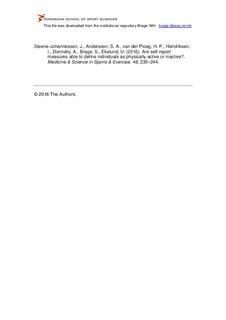| dc.contributor.author | Steene-Johannessen, Jostein | |
| dc.contributor.author | Anderssen, Sigmund A. | |
| dc.contributor.author | van der Ploeg, Hidde P. | |
| dc.contributor.author | Hendriksen, Ingrid | |
| dc.contributor.author | Donnelly, Alan | |
| dc.contributor.author | Brage, Søren | |
| dc.contributor.author | Ekelund, Ulf | |
| dc.date.accessioned | 2016-02-18T10:24:54Z | |
| dc.date.available | 2016-02-18T10:24:54Z | |
| dc.date.issued | 2016-02 | |
| dc.identifier.citation | Medicine & Science in Sports & Exercise. 2016, 48, 235–244. | nb_NO |
| dc.identifier.uri | http://hdl.handle.net/11250/2379485 | |
| dc.description | © 2016 The Authors.
This is an
open access article distributed under the Creative Commons Attribution License
4.0 (CCBY), which permits unrestricted use, distribution, and reproduction
in any medium, provided the original work is properly cited. | nb_NO |
| dc.description.abstract | Purpose: Assess the agreement between commonly used self-report methods compared with objectively measured
physical activity (PA) in defining the prevalence of individuals compliant with PA recommendations. Methods: Time spent in
moderate and vigorous PA (MVPA) was measured at two time points in 1713 healthy individuals from nine European countries using
individually calibrated combined heart rate and movement sensing. Participants also completed the Recent Physical Activity Questionnaire
(RPAQ), short form of the International Physical Activity Questionnaire (IPAQ), and short European Prospective Investigation into Cancer
and Nutrition Physical Activity Questionnaire (EPIC-PAQ). Individuals were categorized as active (e.g., reporting Q150 min of MVPA per
week) or inactive, based on the information derived from the different measures. Sensitivity and specificity analyses and Kappa
statistics were performed to evaluate the ability of the three PA questionnaires to correctly categorize individuals as active or inactive.
Results: Prevalence estimates of being sufficiently active varied significantly (P for all G0.001) between self-report measures (IPAQ
84.2% [95% confidence interval {CI}, 82.5–85.9], RPAQ 87.6% [95% CI, 85.9–89.1], EPIC-PAQ 39.9% [95% CI, 37.5–42.1] and
objective measure 48.5% [95% CI, 41.6–50.9]. All self-report methods showed low or moderate sensitivity (IPAQ 20.0%, RPAQ
18.7%, and EPIC-PAQ 69.8%) to correctly classify inactive people and the agreement between objective and self-reported PA was
low (W = 0.07 [95% CI, 0.02–0.12], 0.12 [95% CI, 0.06–0.18], and 0.19 [95% CI, 0.13–0.24] for IPAQ, RPAQ, and EPIC-PAQ,
respectively). Conclusions: The modest agreement between self-reported and objectively measured PA suggests that population levels of
PA derived from self-report should be interpreted cautiously. Implementation of objective measures in large-scale cohort studies and surveillance
systems is recommended. | nb_NO |
| dc.language.iso | eng | nb_NO |
| dc.publisher | American College of Sports Medicine | nb_NO |
| dc.subject | physical activity | nb_NO |
| dc.subject | sensitivity | nb_NO |
| dc.subject | self-report | nb_NO |
| dc.subject | questionnaire | nb_NO |
| dc.subject | accelerometry | nb_NO |
| dc.title | Are self-report measures able to define individuals as physically active or inactive? | nb_NO |
| dc.type | Journal article | nb_NO |
| dc.type | Peer reviewed | nb_NO |
| dc.subject.nsi | VDP::Social science: 200 | nb_NO |
| dc.subject.nsi | VDP::Social science: 200::Social science in sports: 330 | nb_NO |
| dc.subject.nsi | VDP::Social science: 200::Social science in sports: 330::Other subjects within physical education: 339 | nb_NO |
| dc.source.journal | Medicine & Science in Sports & Exercise | nb_NO |
| dc.description.localcode | Seksjon for idrettsmedisinske fag / Department of Sports Medicine | nb_NO |
